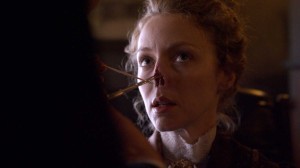
New York-based VFX house Phosphene recently served as the lead VFX house for the critically acclaimed Cinemax series The Knick, helmed by Academy Award- and Emmy-winning director Steven Soderbergh, (Traffic, Side Effects, HBO‘s Behind the Candelabra). The company handled effects that ranged from complex character augmentation to detailed period set extensions, medical enhancements and period anachronisms.
Cinemax recently committed to a second season of the period drama, set in downtown New York in 1900, which centers on Knickerbocker Hospital and the groundbreaking surgeons, nurses and staff, who push the boundaries of medicine in a time of astonishingly high mortality rates and no antibiotics. The series premiered in August.
Under the direction of creative director John Bair and VFX executive producer Vivian Connolly, Phosphene’s team created a CG face replacement for Abigail, a central character played by Jennifer Ferrin, substituting her nose with a CG version to simulate a face disfigured by Syphilis.
“We solved a tricky series of shots together using a combination of CGI, special effects prosthetic elements and compositing,” explained VFX supervisor Lesley Robson-Foster. “Phosphene has a very talented group of artists and Abigail’s nose was a real challenge. I was very pleased with the result, as was Steven Soderbergh.”
VFX producer Parker Chehak added, “No one ever said ‘cool’ or ‘nice work’ when they saw those shots. They always said ‘EW!’ Mission accomplished.”
Abigail’s missing nose had to be both visually striking and subtly personalized. Phosphene started with a special effects face cast provided to them by production. “First, we used PhotoScan to convert photos of the cast to a detailed 3D model,” explained lead digital artist Aaron Raff.
Lead CG artist Vance Miller then proceeded to light and render a physically accurate version of Abigail’s nose-less face in V-Ray. CG artist Kim Lee painstakingly animated all of the slight twitches and stretches of the nose cavity we see as Abigail moves her face and speaks to Dr. Thackery.
“Using NukeX, I integrated these renders of Abigail’s nose cavity onto the footage of the actress, maintaining photo-real lighting across shots that had Abigail moving her head from side to side and passing through light and shadow,” said Raff. “The effect had to be seamless since Abigail’s altered face stayed at the center of the frame for an extended dialogue scene.”
In addition, the creative needs of the show sometimes called for interaction of the surgical instruments within the nose cavity. In those instances, Phosphene created CG extensions for the practical surgical instruments. Phosphene then animated the side flaps of the nose to match the interaction of the CG instrument tips.
“The sequence in which Thackery inspects Abigail’s wounded nose was one of the earliest we worked on and was the most demanding visual effects sequence completed for Season 1,” said Phosphene visual effects producer/compositing supervisor Rebecca Dunn. “Phosphene’s VFX team met early with Lesley Robson-Foster and Parker Chehak to determine the best way to approach this effect which had to appear highly realistic, always maintaining a fine balance between showing Abigail’s disfigurement whilst letting the natural beauty of her character shine through. Phosphene’s previous collaboration with Lesley and Parker working on Richard Harrow’s facial disfigurement in Seasons 3 and 4 of Boardwalk Empire gave us some great experience in how to approach the visual effects for Abigail’s nose.”
Being the first 4K television series undertaken by Phosphene, major technology upgrades were implemented to ensure that they were able to handle the large amounts of data without a hitch, including setting up a state of the art 4K monitor and playback system to provide real-time previews. This enabled Phosphene to review VFX at full resolution in-house. In addition Phosphene utilized tools such as 3ds Max, V-Ray for 3ds Max, NukeX and Agisoft PhotoScan.





